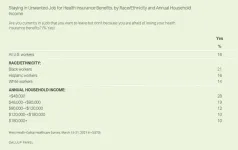(Press-News.org) A team of engineers recommends expanding fast-charging stations for electric vehicles as campuses and businesses start planning for a post-pandemic world.
The recommendation is based on a study of charging patterns for electric vehicles on the University of California San Diego campus from early January to late May of 2020, after the university moved most of its operations online. Researchers say the findings can be applied to a broader range of settings.
"Workplace charging is a critical enabler of carbon-free transportation as the electrons consumed primarily come from solar power plants, as opposed to at-home charging, which occurs at night and relies more on fossil fuel power plants," said Jan Kleissl, the paper's senior author and a professor of environmental engineering at UC San Diego.
It's the first time that a research team gathered information on workplace charging patterns for electric vehicles during the COVID-19 pandemic. As expected, charging declined dramatically once most campus operations became remote. Also as expected, charging at the campus' medical center was less impacted as medical facilities continued most in-person operations and healthcare workers and patients kept using those charging stations.
This reflects nationwide trends. Vehicle travel in the United States declined by about 40 percent from mid-March to mid-April 2020, according to the National Bureau of Economic Research.
But DC fast chargers that provide a full charge in about half an hour were less affected than what is known as Level 2 chargers, which provide a full charge over eight hours. Energy dispatched at Level 2 chargers on the main UC San Diego campus decreased by 84 percent. DC fast charging initially dropped by 67 percent. These stations quickly returned to near-normal usage in a short period of time, unlike Level 2 charging stations.
"This finding reinforces ongoing efforts to deploy at least an additional 20 DCFCs primarily on the perimeter of campus in order to serve both UC San Diego commuters as well as the general public in need of recharging," said Byron Washom, the UC San Diego director of strategic energy initiatives and one of the paper's coauthors.
The team details their findings in the March 23 issue of the Journal of Renewable and Sustainable Energy.
Only four out of 100 stations in the study were fast-charging. More broadly, in the United States, only a tiny fraction of charging stations are fast-charging, and most of those only serve Tesla vehicles. For example, California has about 31,800 EV charging stations. Of those, almost 3000 are Tesla supercharging stations, only available to Tesla vehicles. An additional 470 are DCFC stations managed by California-based Chargepoint.
The study looked at 100 charging stations in 28 parking structures. Specifically, researchers found that from March 11 to May 20, 2020:
Charging on the main campus dropped by 84 percent from pre-pandemic levels
Charging dropped by 50 percent at the parking structures at the UC San Diego medical center locations
Charging at DC fast charging stations initally dropped by 67 percent before going back up to near pre-pandemic levels
Charging will likely not resume back to normal even after the pandemic ends, researchers say.
"Commuting patterns based on five days a week in the office are unlikely to resume, however, as employers may allow more telecommuting even after the end of the pandemic," Kleissl said. .
That may be good news as the anticipated dramatic increase in EV adoption over the coming years would otherwise strain the existing charging infrastructure, he added.
INFORMATION:
Impact of the Coronavirus Pandemic on Electric Vehicle Workplace Charging
Graham McClone, Jan Kleissl, Byron Washom, Sushil Silwal, University of California San Diego
WASHINGTON, DC - MAY 6, 2021 - One out of every six adult workers (16%) in the United States are staying in jobs they might otherwise leave out of fear of losing their employer-sponsored health insurance, according to a new West Health-Gallup survey of more than 3,800 U.S. adults.
The survey finds the fear is even more pronounced among Black workers, who are 50% more likely to remain in an unwanted job than their White and Hispanic counterparts (21% to 14% and 16%, respectively).
But the most likely to stay in a job they would rather leave are those workers in households earning less than $48,000 a year -- roughly 3 in 10 (28%) say they will not leave and risk losing their health benefits. Workers in lower income households are nearly ...
Sophia Antipolis, 6 May 2021: One in four heart attack patients have atypical symptoms such as breathing difficulties, extreme exhaustion, and abdominal pain, according to a study published today in European Heart Journal - Acute Cardiovascular Care, a journal of the European Society of Cardiology (ESC).1 Patients with atypical symptoms were less likely to receive emergency help and more likely to die within 30 days compared to those with chest pain.
"We found that atypical symptoms were most common among older people, especially women, who called a non-emergency helpline for assistance," said study author Ms. Amalie Lykkemark Møller, PhD student, Nordsjællands Hospital, ...
A large study from Denmark and Norway published by The BMJ today sheds more light on the risk of rare blood clots in adults receiving their first dose of the Oxford-AstraZeneca covid-19 vaccine.
The findings show slightly increased rates of vein blood clots including clots in the veins of the brain, compared with expected rates in the general population. However, the researchers stress that the risk of such adverse events is considered low.
Cases of rare blood clots in people who have recently received their first dose of the Oxford-AstraZeneca covid-19 vaccine have been reported. Whether these cases represent excess events above expected ...
The new Danish-Norwegian study is the first study to document possible adverse events in relation to the COVID-19 vaccine Vaxzevria? from AstraZeneca, in which all vaccine recipients have been followed systematically, as opposed to previous studies, which have relied primarily on reported adverse reactions.
The new study was a cooperation between Danish and Norwegian research institutions.
- In this study, we were able to identify all hospital contacts among vaccinated persons by utilising the unique Danish and Norwegian health registers. This ensures that we get a comprehensive of the rate of adverse reactions. ...
Some clinicians are concerned that post-traumatic stress disorder (PTSD) diagnosis has risen throughout Western society since the late 1980s. Is this correct? And if so, has the true incidence of PTSD really spiralled out of control, or has it simply become overdiagnosed?
Experts debate the issue in The BMJ this week.
PTSD is a serious and uncommon condition resulting from severe trauma, but it has unhelpfully become an umbrella term incorporating other disorders and normal reactions to stress, argue John Tully at the University of Nottingham and Dinesh Bhugra at King's College London's Institute for Psychiatry, Psychology & Neuroscience (IoPPN).
Estimates of lifetime population prevalence are now about 7% in the US (26 million cases) and 5% in other high income countries. ...
Admission to an intensive care unit (ICU) is associated with a small increased risk of future suicide or self-harm after discharge compared with non-ICU hospital admissions, finds a study published in The BMJ today.
The findings are particularly relevant during the covid-19 pandemic, as the number of ICU admissions around the world reach all-time highs.
The findings show that survivors of critical illness who later died by suicide or had self-harm events tended to be younger with a history of psychiatric illness, and had received invasive life support.
The researchers stress that the overall risk is still very low, but say knowledge of these factors "might allow for earlier intervention to potentially reduce this important public health problem."
Survival after ...
Israel is the first country to report national data on the Pfizer-BioNTech vaccine, with observational analysis showing that two doses provide more than 95% protection against COVID-19 infection, hospitalisation, and death, including among the elderly, at a time when the B.1.1.7 variant was the dominant strain.
A single dose of the vaccine was associated with 58% protection against infection, 76% against hospitalisation, and 77% against death, emphasising the importance of fully vaccinating adults.
Challenges to controlling the pandemic remain, including uncertainty about ...
R21/Matrix-M becomes the second malaria vaccine candidate ever to start a phase III licensure trial
This builds on the recent finding of high level efficacy of this vaccine in a phase IIb trial in children in Burkina Faso, published today in The Lancet
The first phase III trial doses were administered by the team at the Malaria Research and Training Centre, Bamako, Mali, one of five trial sites across West and East Africa
The malaria vaccine was designed at the Jenner Institute, University of Oxford, who have partnered with the Serum Institute of India for commercial development
The annual death toll from ...
A new mutation found in a gene associated with an increased risk of atrial fibrillation poses a significantly increased risk for heart failure in Black people.
The discovery, made by researchers at the University of Illinois Chicago, could change current guidelines that recommend against genetic testing in people with atrial fibrillations, also known as AFib.
"We found that this new variant confers a significantly increased risk in African Americans, and this mutation has a 50% chance of being passed on to offspring," said Dr. Dawood Darbar, UIC professor of medicine and pharmacology at the College of Medicine. "Since it increases risk for heart failure, it would be wise to test people with atrial fibrillation to see if ...
According to a new study published in the journal Research in Social and Administrative Pharmacy, hospitals that participate in the 340B Drug Pricing Program provide more medication access services -- which are services that help remove barriers to accessing necessary medications -- than comparably sized non-340B hospitals.
The University of Illinois Chicago researchers who conducted the study, which included a survey of available services sent to a nationally representative sample of hospitals across the U.S., suggest that 340B participating hospitals may be better positioned to create and administer programs that support patients who are uninsured ...


